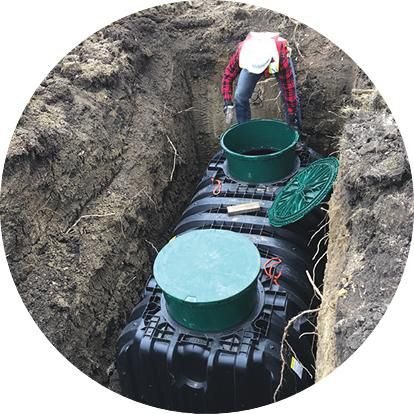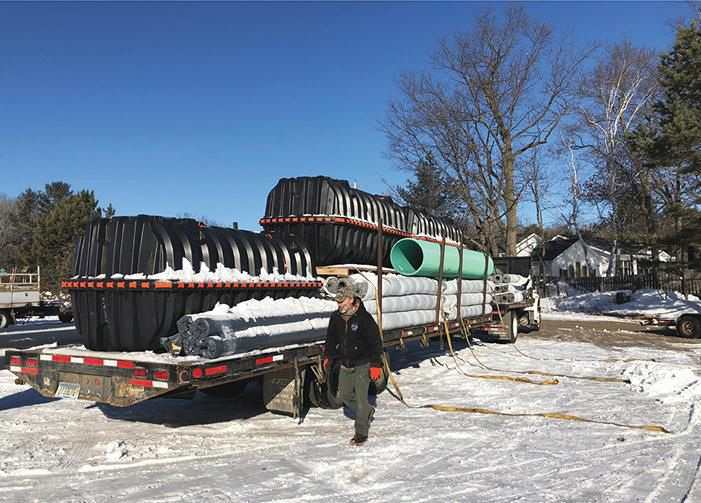Tanks Evolve To Meet Advanced Wastewater Treatment And Water Reuse Demand
By Rachael Atienzar
From simple to advanced and from sewage to potable, tanks have become the Swiss Army knives of water management.
Escalating environmental challenges, local and state regulations, and sustainable development initiatives are all playing a role in the evolution of new tank designs. Advanced wastewater treatment for limited and sensitive sites and rainwater harvesting for potable and non-potable water use are two major areas demanding new approaches to tank construction and use. The demand for lightweight, durable, easy-to-transport tanks to accommodate remote sites has catalyzed the increasing options for plastic. Additionally, elaborate water features in landscaping have been a boost to the development of new, smaller pump tanks.
Tank Materials
Tank materials have evolved based on applications and the size required, with tanks available ranging from 300 gallons up to 10,000 gallons for some plastic tanks. The most common tank size is approximately 2,000 gallons, which serves the bulk of the residential septic marketplace. Plastics and fiberglass are preferred for rainwater capture and potable water systems as both are inert to wastewater constituents, which is a benefit for tank longevity. For potable water systems, the tank must be constructed of virgin, not recycled, material.

Risers are installed on the IM-1060 tanks that house the fixed-film bioreactor (FFBR) system.
Plastic Tanks
These new tank designs are durable, allow easy transport to remote and challenging sites, and are inert to wastewater constituents, boosting longevity. In potable water and rainwater capture systems, plastic tanks have emerged as the top choice. One-piece plastic tanks are generally manufactured by the rotational molding process, thus minimizing leak potential. Two-piece plastic tank designs that include continuous gaskets and feature a fixed, permanent connector system to lock the seam in place are popular with engineers and contractors because of the variety of sizes available and the ease of transport and installation. These high-strength, lightweight tanks are conveniently manufactured in “halves,” allowing the tanks to nest for increased shipping density. For environmentally concerned consumers and businesses, another appeal of the plastic tank is the lower carbon impact of transporting them to the job site.
Fiberglass Reinforced Tanks
Fiberglass reinforced plastic tank sizes range from 300 gallons to 50,000 gallons, with those large tanks most often applied in commercial and municipal applications. Fiberglass tanks are heavier than plastic but are still considerably lighter than concrete tanks and more cost effective than concrete for shipping long distances.
Concrete Tanks
Concrete tanks are still common due to the competitive cost and availability in most parts of the U.S. and are sometimes preferred where high groundwater conditions or poor soils are present. This is because lighter-weight tanks require anti-buoyancy measures in high groundwater situations and can deform under poor soil conditions, like heavy clays.
Specialty and Custom Tanks
Specialty tanks such as pump tanks and tanks that house aerobic treatment units (ATU), popular in environmentally sensitive areas and where site size is limited, are being designed to complement one another. In this case, two-piece tanks that are assembled at the mid-seam allow the treatment products to be installed prior to assembly. In some cases, the treatment products are designed to fit within the manhole opening, generally 20 to 30 inches, for installation after tank assembly.
Tank Sizing
Most often, site and regulatory challenges are key factors in selecting the right type of tank and tank sizing. In all systems utilizing tanks, proper installation is critical for maintaining structural integrity and watertightness. Leaking in, leaking out, or cracks or open seams in any tank compromise treatment and ultimately result in failure.
Stringent wastewater treatment regulations, including in environmentally sensitive areas, are further catalyzing high performance tank designs that enhance overall system design flexibility, ease of component installation, and provisions for maintenance.
Carbon Footprint Considerations
Concern is growing globally over natural resource consumption and climate change. Many governments, companies, and industries are acting to reduce the environmental damages associated with material and product manufacturing and processing. Both natural resource consumption and greenhouse gas emissions are being monitored closely as resource shortages and emissions continue to rise. In the U.S., the onsite wastewater treatment industry currently treats the wastewater generated by nearly 25 percent of households and up to 33 percent of new developments. This amounts to approximately 4 billion gallons of wastewater treated per day. With the vast number of systems installed daily, it is important that the most sustainable methods be used in all aspects of construction, manufacture, transport, and treatment.
Evolving Tank Applications
In wastewater treatment system applications, the need for compact systems for small lots and for systems in environmentally sensitive areas is fueling innovation in tank applications. On difficult sites, the need to install a tank in a shallow, low profile configuration to leverage the available space while avoiding rock or problematic soil conditions is challenging designers to explore new approaches.
Advanced Onsite Wastewater Treatment Systems
Advanced onsite wastewater treatment systems (AOWTS) such as ATUs, membrane bioreactors, and fixed film aeration systems are installed inside a tank and provide exemplary treatment. Some of these are very compact and extremely portable, thereby minimizing site disruption while providing ease of delivery to remote sites. In these cases, the tanks integrity as a treatment vessel is what protects the systems components.
One ATU tank based example is the Delta Treatment Systems' ECOPOD installed in an Infiltrator IM Tank. The ECOPOD is a fixed film aeration system. When air is pumped into the system, the bacteria thrive and grow in much greater numbers than would occur naturally. Nitrification and denitrification occur in a single tank and treat the wastewater to NSF 40/245. Sized from 500 to 1,000 GPD, these systems can be used in series to scale for commercial treatment system needs.
Still another one piece tank and treatment system design is the Fuji tank and treatment in one. It is a compact, one tank unit in which wastewater is settled, treated, filtered, recirculated, and disinfected in the all-in-one design. It is NSF 245 rated and is used in watershed and other sensitive areas such as Suffolk County on Long Island (NY). There, nitrogen from residential septic systems is significant in the degradation of Long Island estuaries where sewering was financially unfeasible. The Suffolk County Health Department’s “Reclaim Our Water Initiative” is an extensive onsite septic demonstration program implementing advanced, primarily tank-based treatment technologies and shallow dispersal drainfields to reduce nitrogen.

Lightweight plastic tanks and other system components were trucked over the ice to the island location.
Serial Tank Configurations
Many wastewater treatment systems are a combination of tank-based approaches. In these serial tank configurations generally using plastic tanks, a system might have a pretreatment tank, a primary treatment tank housing an ATU, and a pump tank.
Septic Tank Effluent Pumping (STEP) Systems
In the case of STEP wastewater collection systems, the size of the system is scalable based on the house size and specifically the number of bedrooms. Wastewater enters the tank, where it is filtered and then pumped to a main sewer line that runs out of the community or to a city sewer, community wastewater treatment plant, or drainfield. Mainly used in new residential community construction, these systems can be installed in phases as the community grows. STEP systems are increasingly popular because there is no disposal on the homeowner’s property.
Other Tanks
Pump tanks, stormwater runoff storage tanks, and agricultural and chemical storage tanks are also evolving to accommodate new regulations and applications.
Tanks In Action
Farm Island ATU System Delivered Across Frozen Minnesota Lake
Farm Island is north of Minneapolis in Farm Island Lake. Here, most installation work stops during the winter, but when Septic Check was asked to design and install a new onsite system for a 1,400-square-foot, year-round dwelling, it took an unusual step by waiting for winter. To enable transporting project materials over the frozen lake to the remote island site, a snowplow truck created a 3,400-foot-long road across the ice to the island. A tank-based ATU system was the ideal choice for this installation because Minnesota regulations require a minimum separation of 3 feet between a conventional system drainfield and the water table. By choosing an ATU and including a UV lamp, the required separation was reduced to 1 foot. Wastewater exits the house via 12 feet of PVC pipe to the first of three Infiltrator IM-1060 1,000-gallon tanks, where settling and anaerobic treatment occurs. Wastewater then flows by gravity into the second tank, where a Delta ECOPOD E50 ATU provides aerobic processing. It leaves the ECOPOD and flows by gravity through a SALCOR UV light to the last tank and is then pumped 65 feet through a 2-inch pipe to a 585-square-foot absorption field. Equipment and supplies were driven across the frozen lake on a trailer, and technicians commuted by snowmobile. An auger was used regularly to bore holes to check the thickness and quality of the ice and ensure safety.
Iowa Town Utilizes Tank-Based Engineered Decentralized Wastewater Treatment Systems
Iowa Department of Natural Resources (IDNR) requires Iowa communities to have engineer-designed wastewater treatment systems. Rowan, IA, had non-compliant systems and no available land for a lagoon. Setbacks, pumping distances, and farmers unwilling to sell land for a system location had stalled the process. A customized tank-dependent engineered solution was designed that includes 50 individual, conventional, code-compliant onsite systems that discharge to chamber drainfields, 16 pump-to-gravity systems that discharge to chamber drainfields, eight ATUs that discharge to chamber drainfields, and 17 STEP systems to a chamber-cluster drainfield system. A total of 50 septic tanks, eight pretreatment units, 32 pump tanks, 20,400 linear feet of Infiltrator chambers, and 6,000 linear feet of 1½-inch force main were utilized for the systems. The systems were installed over a 12-month period, and future system maintenance was considered in all system designs and installations.
Conclusion
While throughout history the tank’s function as a storage vessel hasn’t changed, every other thing surrounding the topic of tanks has, including the types of usage, the materials used, and the rules and regulations surrounding tank applications. Advances in tank manufacturing have added to the potential for largercapacity tanks and for specialized uses such as treatment systems and potable water. These advances have also provided that tanks will meet stringent watertight standards. Tanks have changed to be higher quality and stronger, meet higher standards, and allow more uses.
About The Author
Rachael Atienzar joined Infiltrator Water Technologies in January 2019 as a Project Engineer. She graduated with her B.S. in Geology from the University of New Orleans in 2015. After graduation, she worked for an engineering consultant as a staff geologist in the New Orleans, LA, and Hartford, CT, areas. Rachael spends her time at Infiltrator working on commercial and residential septic system design, product regulation, and research and development initiatives.

